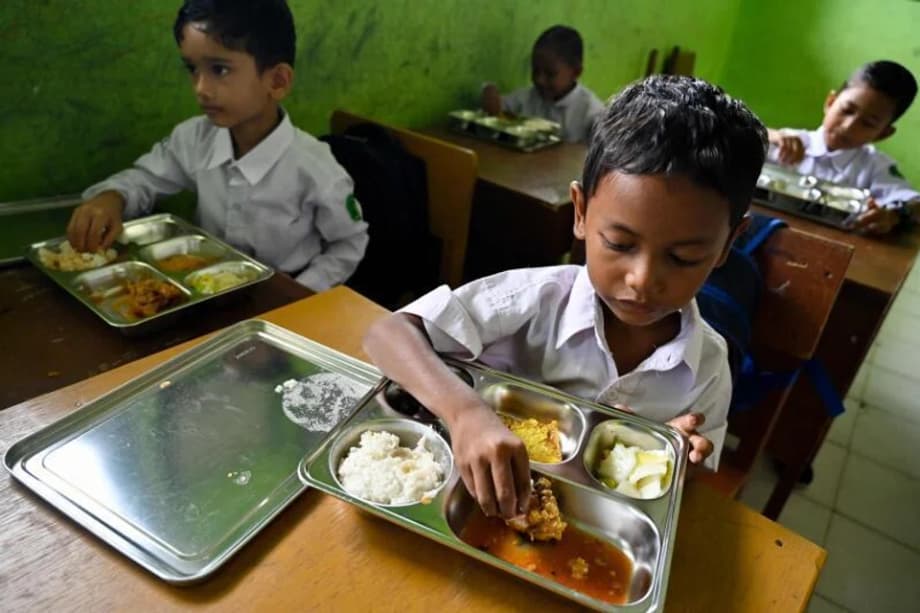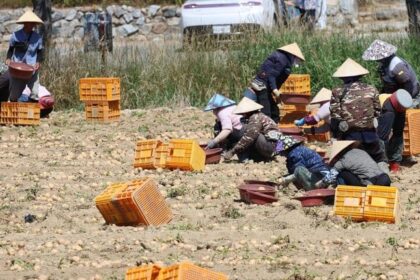Indonesia free meal program faces a safety reckoning
Hundreds of students in Indonesia have fallen ill after eating government-provided school meals in the latest setback for a nationwide nutrition drive that began in January. The newest mass illness struck two schools in Gunungkidul, a district in the Yogyakarta region of central Java, where officials said more than 660 pupils reported symptoms after lunch on October 28. Ten teachers were also affected. Most cases involved diarrhea, nausea and dizziness. Local authorities temporarily suspended the kitchen tied to the meals and advised headmasters supplied by the same facility to monitor students closely and work with community health centers if symptoms appeared.
- Indonesia free meal program faces a safety reckoning
- What happened in Yogyakarta and beyond
- How the program works in a country of 17,000 islands
- Why children are falling ill
- What the government is changing
- The president’s defense of a signature policy
- Money, politics and protests
- What experts say must change now
- What parents and students are experiencing
- At a Glance
The program, known locally as Makan Bergizi Gratis (MBG), is one of President Prabowo Subianto’s signature policies. It aims to fight child malnutrition by providing daily meals to students, as well as to pregnant women and other beneficiaries. Supporters point to the benefits of school meals around the world, from better attendance to improved learning. Indonesia’s rollout has a different story so far. Since January, thousands of children across the archipelago have suffered foodborne illness linked to the program, prompting growing calls from civil society groups and some lawmakers to pause and fix the system before expanding it further.
Officials in Gunungkidul said at least 64 people received treatment at a clinic and a hospital. The kitchen supplying the meals was closed for investigation. The district head, Endah Subekti Kuntariningsih, urged nearby schools to keep careful logs of symptoms and coordinate with health staff. The local health agency chief, Ismono, confirmed the dominant symptoms and said samples were taken for testing. These steps mirror actions seen across Indonesia this year, where kitchens tied to outbreaks have been suspended as inspectors look for the sources of contamination.
What happened in Yogyakarta and beyond
The Gunungkidul cluster is one of several recent mass illnesses tied to MBG meals. In Sragen, Central Java, authorities reported 365 people falling ill after a lunch that included turmeric rice, omelette strips, fried tempeh, salad, sliced apple and milk. In Bengkulu province, about 400 schoolchildren aged 4 to 12 were hospitalized with stomach pain after eating program meals. In West Java’s Garut region, 569 students from five schools became sick after eating chicken and rice from a free meals kitchen. Officials temporarily halted the implicated facilities and collected food samples for laboratory tests.
Laboratories analyzing earlier incidents detected contamination by bacteria that commonly cause food poisoning. In West Java, tests identified Salmonella and E. coli in meals linked to more than 200 sick children. In North Sumatra’s Toba regency, provincial health authorities said samples from a school outbreak contained levels of Bacillus cereus and Staphylococcus aureus above safe thresholds. These bacteria flourish when cooked food sits too long at warm temperatures or when water, utensils or surfaces are not properly sanitized.
Across this year, the number of reported illnesses continues to climb. Indonesia’s food and drug agency told parliament there were 103 food poisoning events from January to September, affecting more than 9,000 children. A nonprofit education network and a public health think tank have documented higher totals by late October. The range in figures reflects the speed of the rollout, different reporting channels and how cases are categorized and verified.
How the program works in a country of 17,000 islands
MBG is designed to cover an enormous population spread across thousands of islands. The agency overseeing the program, the National Nutrition Agency (BGN), has moved from a small start to rapid expansion. Within months, the program went from reaching a few million students at launch to tens of millions of recipients, a mix of schoolchildren, infants and expectant mothers. Government plans target more than 80 million beneficiaries by the end of the year. Officials say new kitchens are being added and more local suppliers are brought into the chain to meet daily demand.
At the heart of the system are catering hubs known as Nutrition Fulfillment Service Units (SPPG). They source ingredients, cook meals in bulk and distribute boxes to schools, often across several neighborhoods or districts. In theory, these units follow strict time and temperature rules, use treated water and sanitize trays, knives and cutting boards. In practice, rapid growth has exposed gaps. Many SPPG are newly established and have limited experience with large volumes, long routes, tropical heat and school schedules that require early-morning cooking and delivery.
The scale is expensive and logistically complex. The government allocated 171 trillion rupiah for 2025, with plans discussed for a larger budget in 2026. Leaders argue the investment is worth it to cut stunting, which affects about one in five Indonesian children under five, and to build habits of healthier eating from an early age. Ensuring food safety in this context depends on strong standards, steady training, reliable oversight and consistent funding for hygiene measures at every step of the chain.
Why children are falling ill
Food safety lapses in new kitchens
Investigators have traced many outbreaks to basic errors in kitchen practice and distribution. The head of Indonesia’s food and drug agency reported a spike in cases since late July and said the main problems came from kitchens that had been operating for less than a month. Common findings included meals delivered several hours after cooking, ingredients kept at room temperature, poor understanding of food safety and a lack of hygiene certification among facilities. In one central Java regency, local health officials assessed dozens of SPPG and found none had the required sanitation eligibility certificate issued by the local government.
Time and temperature control is central to safe school meals. Many bacteria thrive when food sits in the so-called danger zone between refrigerator cold and piping hot. If rice, poultry or eggs are cooked at night and left warm until late morning delivery, bacteria can multiply to dangerous levels. With tropical ambient temperatures, long transport routes and unpredictable traffic, unsafe delays become more likely without strict cutoffs and active cooling or hot-holding methods.
Menus and ingredients under scrutiny
Authorities and health experts have flagged problems with menu design and ingredient handling. Several outbreaks were linked to contaminated cooked chicken or eggs. Others involved sauces past their prime. In one case in West Kalimantan, fried shark appeared on the menu, a choice later criticized due to storage risks and concerns about mercury. In East Java and South Sulawesi, students reported finding maggots in their lunch boxes. In the Riau Islands, parents said they discovered glass fragments in rice. Beyond contamination, nutritionists warn against heavy use of ultraprocessed items like sausages and packaged cookies in school meals intended to teach healthy eating.
Public health nutritionist Tan Shot Yen has urged a shift to fresh, local foods and better menu planning that children will actually eat without compromising nutrition. She also argues that safety must be the first measure of success.
That margin of error is acceptable in a shoe factory. But we are talking about human lives, not a product.
Oversight and a complex supply chain
MBG relies on a web of actors, from central and local agencies to contracted kitchens and transport providers. Early in the rollout, some units operated with limited coordination with local health offices. Lawmakers have raised concerns that too many students are assigned to each kitchen, eroding quality control. Independent audits have found that only a small share of kitchens hold formal hygiene and sanitation certifications. Videos from several kitchens circulated widely this year showing poor washing practices and stagnant rinse water, prompting calls for unannounced inspections and tighter enforcement.
What the government is changing
The National Nutrition Agency says it is tightening standards and retraining staff. Officials have issued new food safety rules for SPPG informed by investigations into recent incidents and by international practice. Key changes include a requirement for certified cooks, a cap on the number of beneficiaries per kitchen, routine testing of raw ingredients and finished meals, and strict sanitation protocols for trays and utensils. Kitchens are required to prepare meals only with sterile water, and staff must follow clear start times so food remains fresh. New guidance bars kitchens from starting prep the day before distribution and instructs cooking to begin at 2 a.m. on the day of delivery to limit time in the danger zone.
BGN leaders say they are conducting surprise inspections and closing kitchens that violate the rules. The government has also set up a high-level coordination team to improve oversight and speed up decisions as the program grows. In areas with outbreaks, local authorities have suspended implicated kitchens, shifted students temporarily to simpler menus and announced that medical treatment costs tied to MBG incidents would be covered when needed.
After visiting students in hospital, the head of BGN, Dadan Hindayana, acknowledged the need for stronger controls.
We must improve quality.
Nanik S. Deyang, the deputy chief of BGN, has publicly acknowledged lapses on the agency’s side as well as the size of the challenge of managing thousands of kitchens at once.
We were negligent in our supervision, we admit that, and for that, we sincerely apologize.
The president’s defense of a signature policy
President Prabowo Subianto has argued that the program’s benefits far outweigh the harms. He cites the massive number of meals delivered and says the share that led to illness is very small in percentage terms. He points to job creation for kitchen staff and farmers supplying ingredients, and says the initiative is helping build a stronger, healthier generation.
We managed to feed 30 million recipients. There are shortcomings; there are food poisonings. We counted all the food that goes out, the deviation, the deficiency, or error is 0.00017 percent.
Public health experts counter that percentages can mask real harm when absolute numbers involve children. They stress that food safety requires a zero-tolerance mindset. The goal is to prevent preventable illness through basic steps, such as cold-chain logistics for perishable items, cooking at safe temperatures, and rejecting any meal that leaves the kitchen too early or arrives after a strict cutoff. They also note that confidence among parents and students is fragile. Each outbreak reduces trust and drives families back to homemade lunches, eroding the program’s purpose.
Money, politics and protests
MBG is among the most expensive school meal programs in the world. Indonesia budgeted 171 trillion rupiah for this year’s rollout and has discussed a larger allocation for next year. To fund several social programs alongside MBG, the government ordered budget cuts in multiple ministries earlier this year. Those cuts fueled protests from university students and civil servants who complained about reduced services and scholarships. The president appealed to prominent business leaders to support MBG and accepted an offer of funding from China. Indonesia’s anti-graft agency warned in March about the risk of mismanagement given the sheer volume of money involved, and police opened an inquiry in one case after a meal provider alleged nonpayment by local authorities.
Public pressure has been intense where clusters struck. In Yogyakarta, groups of mothers banged pots and pans in street protests and urged officials to suspend the program until kitchens meet safety standards. International organizations have also urged careful review of the state’s response to unrest around economic policy, including allegations of heavy-handed policing during demonstrations. For the program to regain public trust, families say visible proof of safer kitchens and transparent reporting will matter more than speeches.
What experts say must change now
Food safety specialists, lawmakers and community groups are converging on a set of practical corrections. They want the government to slow the expansion enough to let kitchen capacity and training catch up. Several lawmakers have urged reducing the number of students served by each kitchen so managers can bring meals from stove to classroom quickly and safely. Health agencies want every SPPG to earn hygiene and sanitation certification and to pass regular audits. BGN’s new protocol makes training mandatory for new and existing staff and requires certification for cooks, but critics say enforcement will make or break the rules.
Nutritionists recommend menus built around fresh local ingredients, prepared the morning of delivery, with less reliance on ultraprocessed products. Schools that already run their own canteens with support from local health offices offer examples of what good practice looks like. One elementary school in Central Java, which has followed a monthly menu planned by a nutritionist since 2015, reports no safety incidents. Parents in that school say they prefer direct control over ingredients, water quality and cleaning. Several community leaders want MBG to allow accredited school-run kitchens to operate under the program, rather than replace them with new units.
Data transparency is another priority. The food and drug agency told parliament that more than 9,000 children were affected from January to September. A nonprofit education network reported a larger number of student illnesses by late October, and a public health think tank has counted nearly 11,500 incidents tied to MBG. Publishing a single, validated dashboard with case definitions and lab results would give parents and schools a clear picture of risk and progress. It would also help identify high performing kitchens that can mentor newer units.
What parents and students are experiencing
Parents describe chaotic scenes at clinics when outbreaks occur. In West Java’s Cipongkor district, hundreds of students were treated within hours, with symptoms ranging from stomach cramps to shortness of breath. A mother said she had to search among dozens of stretchers to find her son after he fell ill mid-meal with a plate of fried chicken, rice, lettuce and fruit. He missed nearly two weeks of classes. In Cianjur, a 16-year-old student said the shredded chicken in his lunch smelled off before he felt dizzy, nauseous and began vomiting. Such accounts have pushed many families to pack homemade food again, at least until they see proof of sustained safety improvements.
Officials say they will increase surprise inspections, shut down kitchens that violate the rules and provide test kits to check ingredients and finished meals. Community leaders are asking for regular briefings at schools, clear escalation paths when children show symptoms and public posting of each kitchen’s certification and inspection record. These steps do not require new technology. They require discipline, planning and a shared priority on safety over volume.
At a Glance
- More than 660 students and 10 teachers fell ill in Gunungkidul, central Java, after MBG meals on October 28
- At least 64 people were treated at a clinic and hospital, and the implicated kitchen was suspended
- Other recent clusters include 365 cases in Sragen, about 400 in Bengkulu and 569 in Garut
- Labs in several incidents detected Salmonella, E. coli, Bacillus cereus and Staphylococcus aureus
- Indonesia’s food and drug agency reported over 9,000 affected children from January to September
- Nonprofits and researchers have counted higher totals by late October as reporting expanded
- BGN issued new rules: certified cooks, per-kitchen caps, sterile water, strict morning-only cooking and food testing
- The government budgeted 171 trillion rupiah in 2025 for MBG, with a larger allocation discussed for 2026
- Some lawmakers want to cut the number of students served by each kitchen to improve safety
- Parents in several regions have protested and demanded a pause until kitchens meet standards
- President Prabowo defends the program’s benefits and says the share of meals tied to illness is very small
- Health experts say trust will return only with consistent compliance, transparent data and swift action against unsafe kitchens












